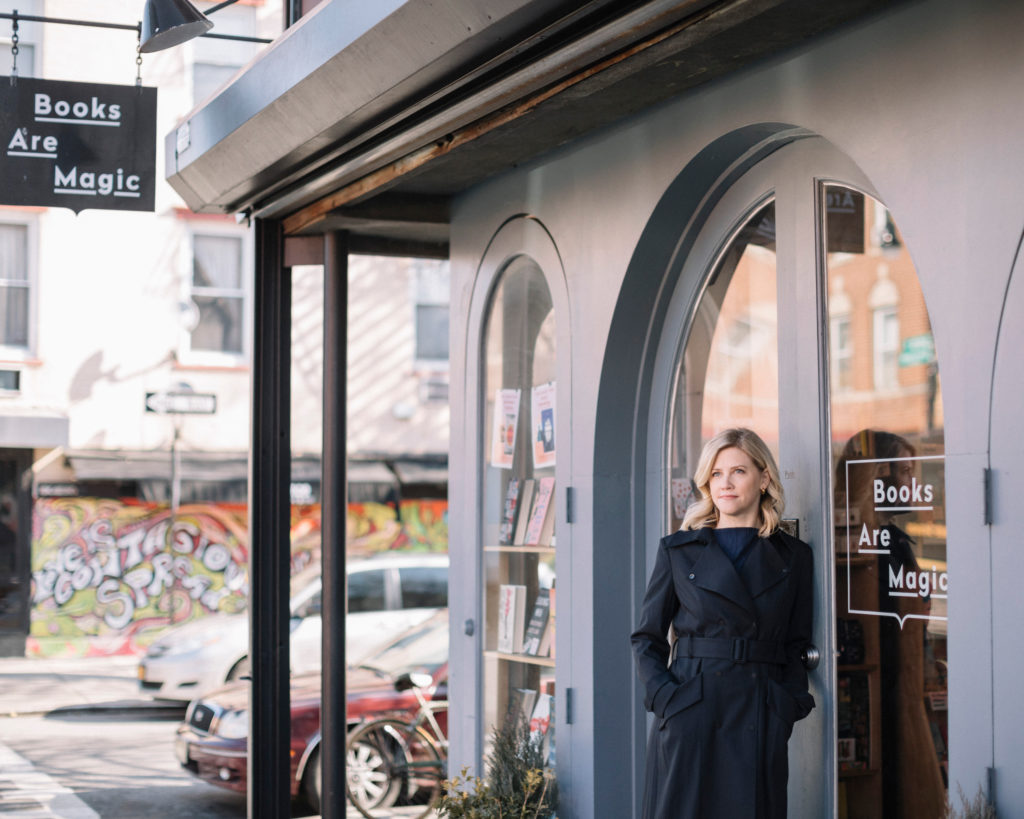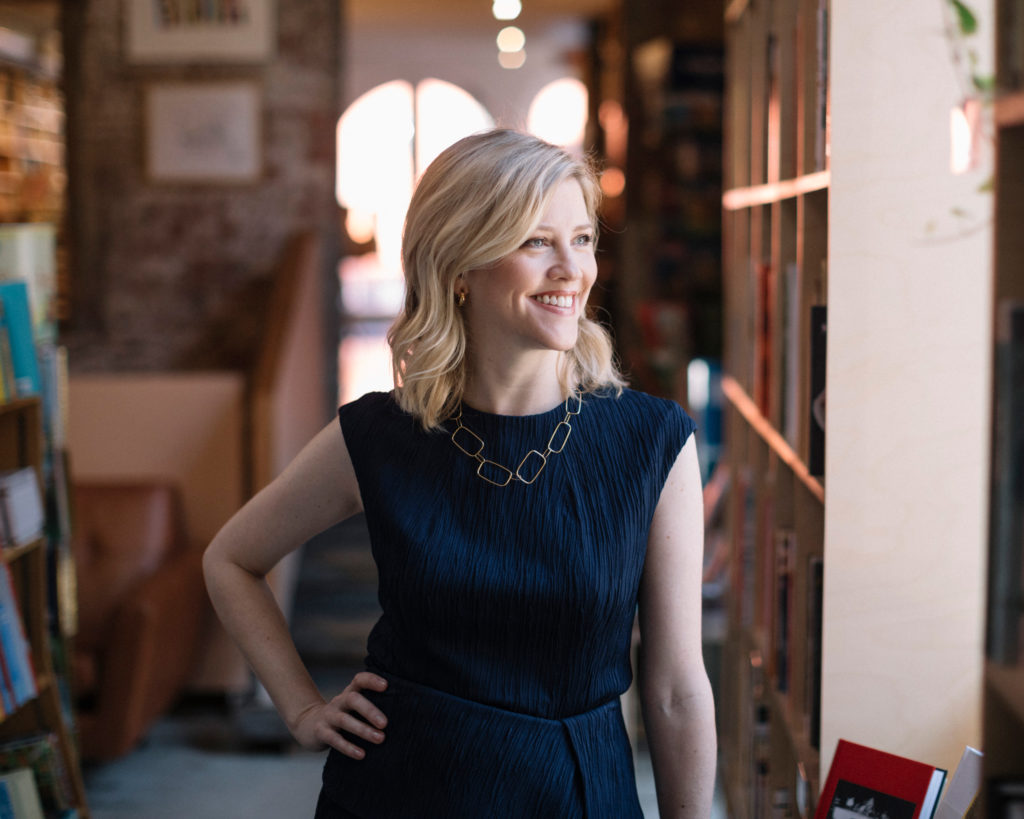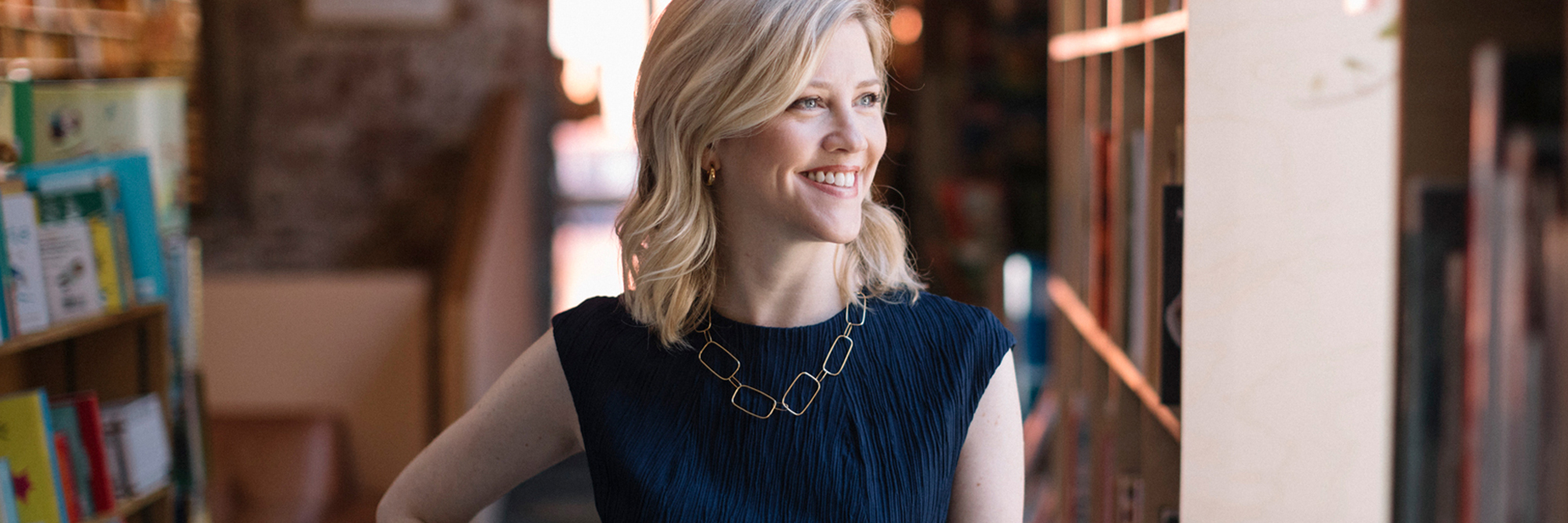Writer Mary Laura Philpott on Perfectionism, Patience, and Reinvention
March 22, 2019 | Filed in: Woman of the Week
When Nashville-based Mary Laura Philpott became an M.M. customer years ago, we all took note. Her emails to her stylist were beautifully written; her Instagram comments were unusually witty; her book recommendations were always on point. “She must be a writer,” we concluded. We were right, and we are beyond thrilled to cheer her on as she launches her debut essay collection, I Miss You When I Blink. In these essays, Mary Laura explores the relationship between work and self, taking a hilarious and self-effacing look at her perfectionist tendencies. She gives us all permission to have the occasional identity crisis in the name of reinvention, and she uses phrases like “Holy hammerheads!” What’s not to love?
If you’re in New York, catch her in conversation with writer-illustrator Mari Andrew at Books Are Magic on April 5 at 7:30 p.m.

Mary Laura wears the Farah top and the Harlem skirt.
AT MY CORE, I AM a very work-driven person. School was great for me because it’s a wonderful scenario for a little baby perfectionist. When you’re that age and that type of person, there’s a very simple equation: I succeed, therefore I am. I got an A-plus on my math test; therefore, I am an A-plus person. It’s easy to unconsciously turn that kind of validation into your definition of self-worth—to believe that as long as you get the right answers, you’re winning at life and you’ll be happy.
BUT WHEN I LEFT SCHOOL, that framework stopped holding up. I was an English major at Davidson College, and I faced what all English majors face their senior year: How does this degree translate to a paycheck? So I did what a lot of people do, which was apply to law school. I aced the LSAT and got into a bunch of schools. Once I was holding all of my acceptance letters, it dawned on me like a horrible storm: I didn’t want to be a lawyer at all.

Mary Laura wears the Osborn trench and the Oak dress.
I PANICKED AT THE LAST MINUTE and wrote to all the law schools that had accepted me, “Sorry. I’ve made a mistake.” I walked to the careers office at my college and learned that there were a few companies still interviewing on campus, one of which was the consulting company Accenture. So what does a little Type-A person do when met with a challenge? She proves that she can do it. I got the job as an analyst and went off and learned how to program software. It was such a poor fit.
I WAS ENTERING A MORE COMPLICATED PHASE OF LIFE, where there’s not a clear “right” answer. And if you’re someone whose self-worth hinges on being right, the realization that you may have made the wrong choice (whether it’s a job choice, a relationship choice, a personal choice) doesn’t just feel wrong—it feels catastrophic. And then it seems like there’s this false dichotomy: You can either dig in and force yourself to be happy with the choice you’ve made, or you can blow up your life and start over. I wanted to tell a different story in my book of essays. I wanted to tell the story of how you can reinvent your life in a series of small recalibrations.

Mary Laura wears the Eugenia top, the Montgomery skirt, the Ginger pump, and the Europa necklace.
I THINK IT’S COMMON TO HAVE A SMALL IDENTITY CRISIS every few years as you reach different forks in the road. Not the classic mid-life crisis—“I have to go buy a Corvette or dye my hair blue”—but a smaller crisis where you say, “I know who I am, but what the hell am I doing with my life right now?” I eventually took a big leap off the corporate ladder and went to work in communications. And ultimately, I became a freelance writer. For me, finding my way back to myself meant remembering what’s essential for me: I love being part of a vibrant creative community; I love living and working near nature; and I love animals. Without those things, I feel lonely. I don’t feel like myself.
PUBLISHING THIS BOOK IS DEFINITELY THE HIGHLIGHT of my career so far. I’m just glad I finished writing it! When you work on a long creative project, there are so many moments when you can bail and so many good excuses to quit. I’m proud that I made myself keep typing, and I’m deeply grateful to other writers who told me that wanting to quit was normal. Because if you think you’re the only one having a problem, that loneliness makes it even worse. It’s comforting to share stories and to know that everyone struggles with this process. That’s true of life in general. Sharing our stories makes us feel more connected.

Mary Laura wears the Farah top, the Harlem skirt, and the Ginger pump.
I AM NOT GREAT AT PUTTING OUTFITS TOGETHER. If you send me shopping, I will find one piece that I love, but I’ll have no idea how to assimilate it into my wardrobe. Most days, I’m just in jeans, but parts of my job involve being visible, and I have to look put-together. Last fall, I interviewed Sally Field in front of a thousand people. I also host a show on public television, and that audience does not want to see me in ripped jeans. That’s what’s so helpful about M.M.—it has been such a joy to find a place where I know what my size is, I know what fits me, and I know which fabrics are washable. So I can just go on the website and be like, “Bam—I know what I’m wearing on TV this year.” My go-to dresses are the Isabelle and the Aditi, which I have worn seven million times.
DEEP DOWN IN MY NATURE, I still struggle with the feeling that my work is my worth. If I am producing good, successful work every day, then I am succeeding as a person. But I know that doesn’t add up in a healthy way, and it’s not the example that I want to set for my children. There are going to be times when you fail, or when you delete more words than you write in a day. Sometimes you have to do things wrong in order to ultimately do them right. It took me a long time to learn that messing up and then recalibrating is part of the process. In fact, it is the process.

Mary Laura wears the Eugenia top, the Montgomery skirt, the Ginger pump, and the Europa necklace.
Photographs by Rich Gilligan. Styling by Chris Walsh. Photos taken at Books Are Magic.





